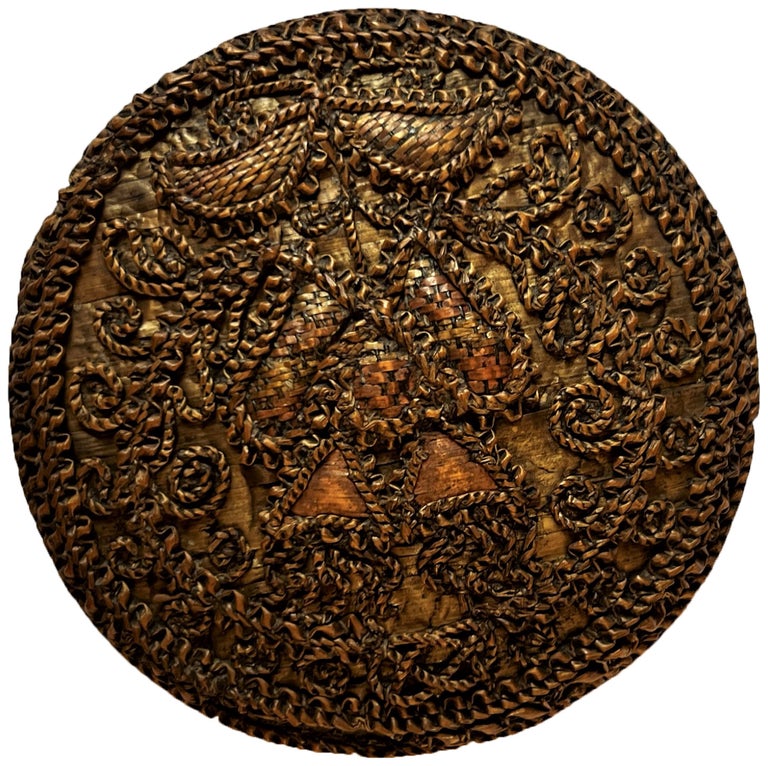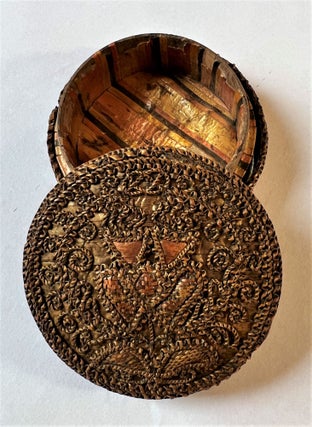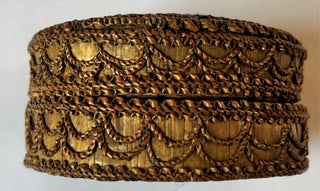Small round box decorated with straw marquetry and embroidery. [France, 18th century].
A two-part round wooden box, approx. 68 mm in diameter x 30 mm. high, the top slightly rounded, top and sides covered in decorative designs composed of bands of straw marquetry overlaid with twisted and embroidered straw-work, the design on upper cover with sections in relief, the bottom of the box undecorated, the interior lined in strips of multi-colored straw. Condition: loss of one hook of the looped ribbon on sides, slight ungluing of straw decoration on bottom part; the straw lining with some swelling and irregularities, but overall in excellent condition. ***
A lovely decorative box, possibly a “boîte à poudre” for face powder. The cover is decorated with a flowering plant, its flowers made of tiny flat bands of straw with leaves of interwoven straw, petals and leaves outlined in embroidered straw, and the rest of the surface decorated with embroidered tendrils. The sides of both sections are decorated with a continuous looped garland.
“Starting in the 17th century and throughout the 18th century, elegant women carried around their necks or in their pockets a proliferation of bibelots, boxes, tubes and other miniaturized nécéssaires, most intended for perfumes or makeup, They also appeared in their bedrooms.`Their rooms are cluttered with thousands of boxes,’” complained one contemporary in 1642. (Caunes & Baumgartner, p. 148, transl). Sold by marchands-merciers, these accessories came in all sorts of materials, from the most expensive materials like porcelain or ivory, to the humblest, like straw. In spite of the inexpensive and accessible material, straw creations during this period, which often combined the techniques of straw-plaiting, straw marquetry, and a method of using straw in embroidery, could be exquisite.
The box was probably made by nuns. Straw marquetry and straw embroidery were associated early on in France with nuns’ handiwork, in the production of both religious and secular objects, often produced for sale outside the convent. Straw was cheap and abundant, and working it demanded skill rather than any expensive materials or sophisticated preparation. To make a palette resembling wood veneer, wheat or oat straw was split, soaked for a time in water, and then ironed. From this basic technique, two main decorative techniques evolved, one using straw marquetry and the other relief embroidery. This little box uses both. An example of a larger box using the same techniques is reproduced by Caunes, et al., p. 62. A similar box, measuring approx 11 x 6 cm, is currently being offered by a New York antiques dealer (for $14,000).
While externally the colors of the box are somewhat muted, the original bright colors of the dyed straw strips have been preserved in its inner lining.
Cf. Lison de Caunes, Serge Goldsal, & Catherine Baumgartner, La Marqueterie de Paille (Paris: les Editions de l'Amateur, 1993), passim. Item #4280
Price: $1,750.00



